Trivolt HEATING MAT

A heating mat is composed of a thin resistive heating cable, which is affixed to a self-adhesive mesh made of fiberglass. This type of heating mat is specifically designed for use in electric underfloor heating systems, where its primary purpose is to deliver consistent, energy-efficient heat to various spaces. The thin resistive heating cable, which forms the core of the mat, is carefully engineered to ensure optimal performance. It is placed in a pre-determined layout on the fiberglass mesh to evenly distribute heat across the surface it covers. The mesh itself serves not only as a stable base for the cable but also as a medium that simplifies the installation process, allowing for quick and precise placement during setup.
The heating cable within the mat is constructed using a multi-stranded Ni-Cr (Nickel-Chromium) wire. This particular material is chosen for its outstanding ability to convert electrical energy into heat through the process of electrical resistance.
The use of a multi-stranded Ni-Cr resistive cable ensures effective heat generation, while the protective layers of Teflon, grounding braid, and PVC insulation provide safety, durability, and resistance to environmental stress.


